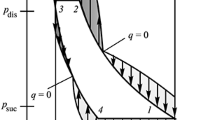Abstract
The energy balance, air internal energy, enthalpy and exergy transfers of high pressure switching expansion reduction (SER) are comparatively analyzed in this paper to give a better understanding about the exergy analysis and its difference between energy conversion analyses for the pneumatics. In SER, the exergy transfer efficiency is much lower than the enthalpy efficiency. The enthalpy efficiency is primarily related to the initial pressure of supply tanks, and the exergy efficiency is primarily related to the pressure reduction ratios. Heat transfers increase the internal energy, enthalpy and exergy of air; the influence on exergy is relatively small. The total enthalpy in SER decreases as the air temperature decreases in the expansion process of the air. And exergy loss is primarily related to the irreversible process of isenthalpic throttling but not energy conversion. Based on the analyses, to improve the exergy efficiency of the pneumatics, the pressure reduction without power output should be avoided.
Similar content being viewed by others
References
Chen Ying, Xu Hong, Tao Guo-liang, et al. Research and progress of the compressed air power vehicle [J]. Chinese Journal of Mechanical Engineering, 2002, 38(11): 7–11 (in Chinese).
Cavallo A. Controllable and affordable utility-scale electricity from intermittent wind resources and compressed air energy storage (CAES) [J]. Energy, 2007, 32(2): 120–127.
Sciubba E. Beyond thermoeconomics? The concept of extended exergy accounting and its application to the analysis and design of thermal systems [J]. Exergy, an International Journal, 2001, 1(2): 68–84.
Rosen M A. Energy-and exergy-based comparison of coal-fired and nuclear steam power plants [J]. Exergy, an International Journal, 2001, 1(3): 180–192.
Ahern J E. The exergy method of energy systems analysis [M]. New York: John Wiley and Sons, 1980.
Baehr H D. Thermodynamics-An introduction to the fundamentals and technical applications [M]. Berlin: Springer-Verlag, 1981 (in German).
Van Wylen G J, Sonntag R E. Fundamentals of classical thermodynamics [M]. New York: John Wiley and Sons, 1985.
Setoguchi T, Santhakumar S, Maeda H, et al. A review of impulse turbines for wave energy conversion [J]. Renewable Energy, 2001, 23(2): 261–292
Pan R, Wypych PW. Pressure drop and slug velocity in low-velocity pneumatic conveying of bulk solids [J]. Powder Technology, 1997, 94(2): 123–132.
Cai M, Kaeashima K, Kagawa T. Power assessment of flowing compressed air [J]. Journal of Fluids Enginnering, 2006, 128(2): 402–405.
Cai M, Kagawa T. Design and application of air power meter in compressed air systems [C]// 2nd International Symposium on Environmentally Conscious Design and Inverse Manufacturing (EcoDesign’01). Tokyo: IEEE, 2001: 208–212.
Szargut J, Morris D R, Steward F R. Exergy analysis of thermal, chemical, and metallurgical processes [M]. New York: Hemisphere Publishing, 1988.
Kotas T J. The exergy method of thermal plant analysis [M]. Stoneham, MA: Butterworth Publishers, 1985.
Luo Y, Wang X. Exergy analysis on throttle reduction efficiency based on real gas equations [J]. Energy, 2010, 35(1): 181–187.
Jin Ying-zi, Li Jun, Bao Gang, et al. The effect and determination of the overall coefficient of heat transfer in pneumatic charging and discharching system [J]. Journal of Harbin Institute of Technology, 1998, 30(1): 15–19 (in Chinese).
Zheng Zhi, Wang Shu-li, Wang Bang-hua. Exergy analysis in the pressure reduction process at the city gas gate stations [J]. Natural Gas Industry, 2009, 29(5): 104–106 (in Chinese).
Author information
Authors and Affiliations
Corresponding author
Additional information
Foundation item: the National Natural Science Foundation of China (No. 50575202)
Rights and permissions
About this article
Cite this article
Luo, Yx., Wang, Xy. & Lei, Jb. Enthalpy and exergy transfers of high pressure switching expansion reduction. J. Shanghai Jiaotong Univ. (Sci.) 17, 45–52 (2012). https://doi.org/10.1007/s12204-012-1228-6
Received:
Published:
Issue Date:
DOI: https://doi.org/10.1007/s12204-012-1228-6



